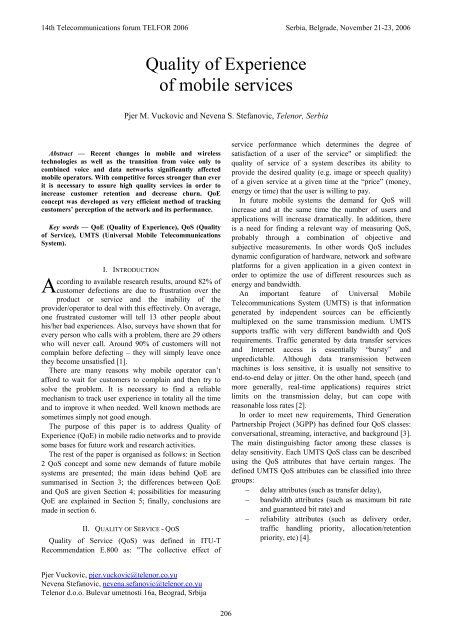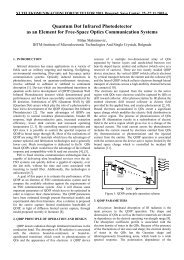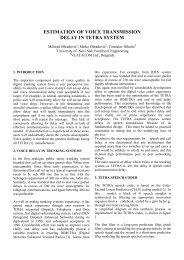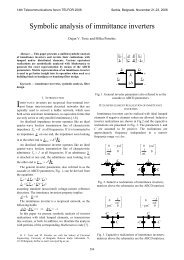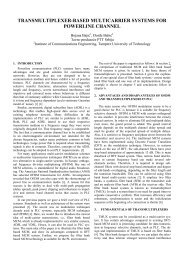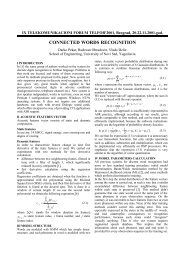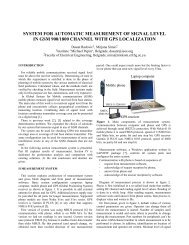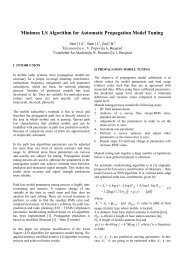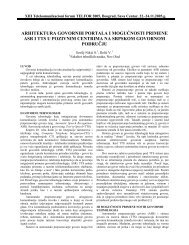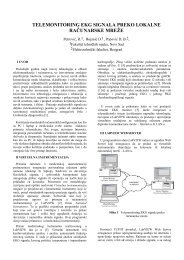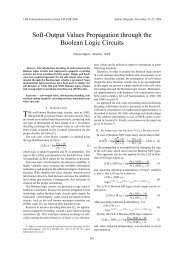Quality of Experience of mobile services - Telfor
Quality of Experience of mobile services - Telfor
Quality of Experience of mobile services - Telfor
You also want an ePaper? Increase the reach of your titles
YUMPU automatically turns print PDFs into web optimized ePapers that Google loves.
14th Telecommunications forum TELFOR 2006 Serbia, Belgrade, November 21-23, 2006<strong>Quality</strong> <strong>of</strong> <strong>Experience</strong><strong>of</strong> <strong>mobile</strong> <strong>services</strong>Pjer M. Vuckovic and Nevena S. Stefanovic, Telenor, SerbiaAbstract — Recent changes in <strong>mobile</strong> and wirelesstechnologies as well as the transition from voice only tocombined voice and data networks significantly affected<strong>mobile</strong> operators. With competitive forces stronger than everit is necessary to assure high quality <strong>services</strong> in order toincrease customer retention and decrease churn. QoEconcept was developed as very efficient method <strong>of</strong> trackingcustomers’ perception <strong>of</strong> the network and its performance.Key words — QoE (<strong>Quality</strong> <strong>of</strong> <strong>Experience</strong>), QoS (<strong>Quality</strong><strong>of</strong> Service), UMTS (Universal Mobile TelecommunicationsSystem).AI. INTRODUCTIONccording to available research results, around 82% <strong>of</strong>customer defections are due to frustration over theproduct or service and the inability <strong>of</strong> theprovider/operator to deal with this effectively. On average,one frustrated customer will tell 13 other people abouthis/her bad experiences. Also, surveys have shown that forevery person who calls with a problem, there are 29 otherswho will never call. Around 90% <strong>of</strong> customers will notcomplain before defecting – they will simply leave oncethey become unsatisfied [1].There are many reasons why <strong>mobile</strong> operator can’tafford to wait for customers to complain and then try tosolve the problem. It is necessary to find a reliablemechanism to track user experience in totality all the timeand to improve it when needed. Well known methods aresometimes simply not good enough.The purpose <strong>of</strong> this paper is to address <strong>Quality</strong> <strong>of</strong><strong>Experience</strong> (QoE) in <strong>mobile</strong> radio networks and to providesome bases for future work and research activities.The rest <strong>of</strong> the paper is organised as follows: in Section2 QoS concept and some new demands <strong>of</strong> future <strong>mobile</strong>systems are presented; the main ideas behind QoE aresummarised in Section 3; the differences between QoEand QoS are given Section 4; possibilities for measuringQoE are explained in Section 5; finally, conclusions aremade in section 6.II. QUALITY OF SERVICE -QOS<strong>Quality</strong> <strong>of</strong> Service (QoS) was defined in ITU-TRecommendation E.800 as: "The collective effect <strong>of</strong>service performance which determines the degree <strong>of</strong>satisfaction <strong>of</strong> a user <strong>of</strong> the service" or simplified: thequality <strong>of</strong> service <strong>of</strong> a system describes its ability toprovide the desired quality (e.g. image or speech quality)<strong>of</strong> a given service at a given time at the “price” (money,energy or time) that the user is willing to pay.In future <strong>mobile</strong> systems the demand for QoS willincrease and at the same time the number <strong>of</strong> users andapplications will increase dramatically. In addition, thereis a need for finding a relevant way <strong>of</strong> measuring QoS,probably through a combination <strong>of</strong> objective andsubjective measurements. In other words QoS includesdynamic configuration <strong>of</strong> hardware, network and s<strong>of</strong>twareplatforms for a given application in a given context inorder to optimize the use <strong>of</strong> different resources such asenergy and bandwidth.An important feature <strong>of</strong> Universal MobileTelecommunications System (UMTS) is that informationgenerated by independent sources can be efficientlymultiplexed on the same transmission medium. UMTSsupports traffic with very different bandwidth and QoSrequirements. Traffic generated by data transfer <strong>services</strong>and Internet access is essentially “bursty” andunpredictable. Although data transmission betweenmachines is loss sensitive, it is usually not sensitive toend-to-end delay or jitter. On the other hand, speech (andmore generally, real-time applications) requires strictlimits on the transmission delay, but can cope withreasonable loss rates [2].In order to meet new requirements, Third GenerationPartnership Project (3GPP) has defined four QoS classes:conversational, streaming, interactive, and background [3].The main distinguishing factor among these classes isdelay sensitivity. Each UMTS QoS class can be describedusing the QoS attributes that have certain ranges. Thedefined UMTS QoS attributes can be classified into threegroups: delay attributes (such as transfer delay), bandwidth attributes (such as maximum bit rateand guaranteed bit rate) and reliability attributes (such as delivery order,traffic handling priority, allocation/retentionpriority, etc) [4].Pjer Vuckovic, pjer.vuckovic@telenor.co.yuNevena Stefanovic, nevena.sefanovic@telenor.co.yuTelenor d.o.o. Bulevar umetnosti 16a, Beograd, Srbija206
TABLE 1: UMTS TRAFFIC CLASSES.QoS ClassTransferdelayrequirementTransferdelayvariationLow biterrorrateGuaranteedbitrateExampleConversational Stringent Stringent No YesStreaming Constrained Constrained No YesInteractive Looser No Yes NoBackground No No Yes NoVoIP, Video Conferencing, AudioconferencingBroadcast <strong>services</strong> (audio, video),News, SportWeb browsing, Interactive Chat,Games, m-commerceE-mail, SMS, database downloads,transfer <strong>of</strong> measurementsConversational class is the most sensitive, whilebackground is the least sensitive. Conversational andstreaming classes are intended for real-time traffic. Theyboth preserve time relation (variation) betweeninformation elements <strong>of</strong> the stream, however,conversational class has more rigorous delayrequirements. Example applications are IP telephony forthe former and streaming video for the latter. For theinteractive and background classes, transfer delay is not asimportant. Instead, they both preserve the payload content.Interactive class follows a request-response pattern anddefines three priorities to differentiate between bearerqualities, while it does not provide explicit qualityguarantees. Background’s main characteristic is that thedestination does not expect the data within a certain time.Example applications are FTP or Web traffic forinteractive and download <strong>of</strong> emails for background class.Summary <strong>of</strong> the main QoS requirements and typical<strong>services</strong> and applications is given in Table 1.III. QUALITY OF EXPERIENCE -QOE<strong>Experience</strong>s are actively constructed and developed bypeople interacting with the environment through asubjective process.The experience <strong>of</strong> a product/service may be defined indifferent ways. However, many authors agree that itshould comprise <strong>of</strong> all elements influencing interactionbetween the user and the product/service provided [5], [6].From user’s perspective, various attributes <strong>of</strong> theproduct have importance in determining experience. Theproduct should be needed and appropriate, and its usemanageable and learnable. Some users will valueaesthetics, others effectiveness. However, all <strong>of</strong> theseaspects are value adding and hence <strong>of</strong> great importance forthe provider <strong>of</strong> the service.User <strong>of</strong> a service has predetermined and usually welldefined expectations. These expectations mainly focus onusability, ease <strong>of</strong> interaction and performance <strong>of</strong> thesystem [7]. For the user to be satisfied with the experience,expectations must be met.While interacting with the environment, peopleexperience sensations, perceptions and opinions. Thecharacteristics <strong>of</strong> these experiences determine the overallquality <strong>of</strong> experience [6].<strong>Quality</strong> <strong>of</strong> <strong>Experience</strong> is not a metric by itself. In terms<strong>of</strong> applying QoE to <strong>services</strong> provided by 2G or 3Goperator, it is a ''concept comprising all the elements <strong>of</strong> asubscriber’s perception <strong>of</strong> the network and its performanceand how they meet expectations'' [8]. Factors such as cost,reliability, availability, usability, utility and fidelity areidentified to be critical for determining QoE <strong>of</strong> <strong>mobile</strong>networks (Figure 1).FIGURE 1: FACTORS CRITICAL FOR DETERMENING QOE.High QoE would indicate that the user’s experiencewith the service provided is good. On the other hand, lowQoE means that user’s experience <strong>of</strong> the network is notsatisfactory.The quality as experienced by the user (QoE) is themost important measure for the operator to properlydimension its network. The key is to find a balancebetween over provisioning and low quality extremes.While over provisioning quality is costly and inefficient,low quality might have a negative effect on churn [9].Understanding users’ expectations and identifying thedrivers <strong>of</strong> users’ satisfaction are necessary for determiningeffective QoE indicators.IV. QOE VERSUS QOSTo better understand the differences between QoS and207
QoE (as well as the requirements given to the operator andthe end user) it is necessary to provide detailedexplanation <strong>of</strong> the relation between these two factors.From customer's point <strong>of</strong> view there are four aspects <strong>of</strong>service use: Network Access, Service Access, ServiceIntegrity and Service Retainability [10].The meaning and explanation for each <strong>of</strong> these QoSaspects is as follows. Network Access: The network indication on thedisplay <strong>of</strong> the <strong>mobile</strong> is a signal to the customerthat he can use the service <strong>of</strong> this networkoperator. Service Access: If the customer wants to use aservice, the network operator should provide himas fast as possible access to the service. Service Integrity: This describes the <strong>Quality</strong> <strong>of</strong>Service during service use. Service Retainability: Service Retainabilitydescribes the termination <strong>of</strong> <strong>services</strong> (inaccordance with or against the will <strong>of</strong> the user).QoS is intrinsically a technical concept which usuallyhas little influence on a user. It is only a subset <strong>of</strong> theoverall QoE scope. Although higher QoS network wouldin many cases result in higher QoE, fulfilling all trafficQoS parameters will not guarantee high users’ <strong>Quality</strong> <strong>of</strong><strong>Experience</strong>.V. MEASURING QOEQoE is not a metric by itself and it is very subjective bynature. However, devising a strategy to measure QoE asrealistically as possible is <strong>of</strong> crucial importance for serviceprovider. In fact, knowing user perceived QoE, theoperator can estimate the contribution <strong>of</strong> networkperformance to the overall level <strong>of</strong> customer satisfaction.Reliability, availability, scalability, speed, accuracy andefficiency are the main elements that define QoE and atthe same time can provide competitive advantage innowadays packet based communication networks.<strong>Experience</strong> is expressed in words rather then metrics andcan be excellent, very good, good, fair or poor [8].There are two approaches for measuring QoE: servicelevel approach (uses statistical samples) and networkmanagement system approach (uses QoS parameters).Service level approach includes identifying andweighting QoE Key Performance Indicators (KPI),weighting the key applications, devising a properstatistical sample (like geographic areas, traffic mix etc.),utilising user agents in the handsets to make the resultsmore accurate and giving an overall QoE index from KPIvalues for each separate service and service mix.Network management system approach includesidentifying the relationship between QoS KPIs and theireffect on QoE and measuring QoS KPIs in the network torate QoE <strong>of</strong> users. While network management systemapproach seams ideal for operators (even though it isvendor dependent), it is very difficult to identify theproper relationship between network QoS KPIs and userexperience (QoE). Service level approach, on the otherhand, provides the opportunity to measure QoE for anynetwork without access to operator products (such asnetwork management system). It is operator and vendorindependent, relatively inexpensive and appropriate forbenchmarking.However, in order to obtain the most accurate results,the best option is for the operator to combine bothapproaches in a complementary way [8].VI. CONCLUSIONManaging QoE in a multi service network is one <strong>of</strong> themost challenging aspects <strong>of</strong> <strong>mobile</strong> network design. In<strong>mobile</strong> telecommunications <strong>of</strong> the future, by properlydimensioning and maintaining high QoE network,operators may gain critical competitive advantage. UMTSis the first wireless technology in which serious emphasison end-to-end QoS has been given.The purpose <strong>of</strong> this paper is to provide an overview <strong>of</strong>QoE concept in <strong>mobile</strong> networks, to explain how QoErelates to QoS and to outline the challenges <strong>mobile</strong>operators have today. Future work will be concentrated oncareful analysis <strong>of</strong> available <strong>services</strong> and, in the nextphase, defining exact QoE targets and possibilities formeasuring QoE for each <strong>of</strong> identified <strong>services</strong>.QoE is a new concept in <strong>mobile</strong> networks. The authorsattempted to (through synthesis <strong>of</strong> knowledge gained fromexperience, and available literature in this field) stress that,in UMTS networks, it is critical for operators to focus onboth QoS KPIs on one hand, and customers’ expectationsand perception <strong>of</strong> the service on the other in order to beable to properly dimension and manage <strong>mobile</strong> network.LITERATURE[1] Fiedler, M. “The Role <strong>of</strong> <strong>Quality</strong> Feedback for Perceived ServiceDependability”, http://iplu.vtt.fi/digitalo/dependability_espoo_060518_mf.pdf, accessed on July 25, 2006.[2] Baudet, S. et al. “QoS implementation in UMTS networks”, AlcatelTelecommunications Review, quarter 1, 2001.[3] 3GPP TS 23.107 Technical Specification Group Services andSystem Aspects; <strong>Quality</strong> <strong>of</strong> Service (QoS) concept and architecture.[4] Chuah, M.C. et al. “Design and Performance <strong>of</strong> 3GNetworks/WLANs”, Springer, Boston, MA, page 41, 2005.[5] Patrick, A. Et al. “A QoE Sensitive Architecture for AdvancedCollaborative Environments”, The first international conference on<strong>Quality</strong> <strong>of</strong> Service in heterogeneous wired/wireless networks(QSHINE 2004), October 18-20, 2006 Dallas, TX.[6] Lauralee, A. “<strong>Quality</strong> <strong>of</strong> experience: defining the criteria foreffective interaction design”, Interactions, Volume 3, Issue 3,May/June 1996.[7] Fiedler, M. “State-<strong>of</strong>-the-art with regards to user-perceived <strong>Quality</strong><strong>of</strong> Service and quality feedback”,http://eurongi.enst.fr/p_en_WPs_JRAWP_WPJRA6_140.html,accessed on July 25, 2006.[8] Nokia White Paper “<strong>Quality</strong> <strong>of</strong> <strong>Experience</strong> (QoE) <strong>of</strong> <strong>mobile</strong><strong>services</strong>: Can it be measured and improved?”,http://www.nokia.com/NOKIA_COM_1/Operators/Downloads/Nokia_Services/whitepaper_qoe_net.pdf, accessed on July 25, 2006.[9] Laiho, J. Et al. “Advanced Analysis Methods for 3G CellularNetworks”, http://www.cis.hut.fi/kimmo/papers/twc05.pdf,accessed on July 25, 2006.[10] ETSI TS 102 250 Speech Processing, Transmission and <strong>Quality</strong>Aspects (STQ); QoS aspects for popular <strong>services</strong> in GSM and 3Gnetworks; Part 1: Identification <strong>of</strong> <strong>Quality</strong> <strong>of</strong> Service aspects.208
ABSTRACTRecent changes in <strong>mobile</strong> and wireless technologies aswell as the transition from voice only to combined voiceand data networks significantly affected <strong>mobile</strong> operators.With competitive forces stronger than ever it is necessaryto assure high quality <strong>services</strong> in order to increasecustomer retention and decrease churn. QoE concept wasdeveloped as very efficient method <strong>of</strong> tracking customers’perception <strong>of</strong> the network and its performance.QUALITY OF EXPERIENCE OF MOBILESERVICESP. Vuckovic, N. Stefanovic209


